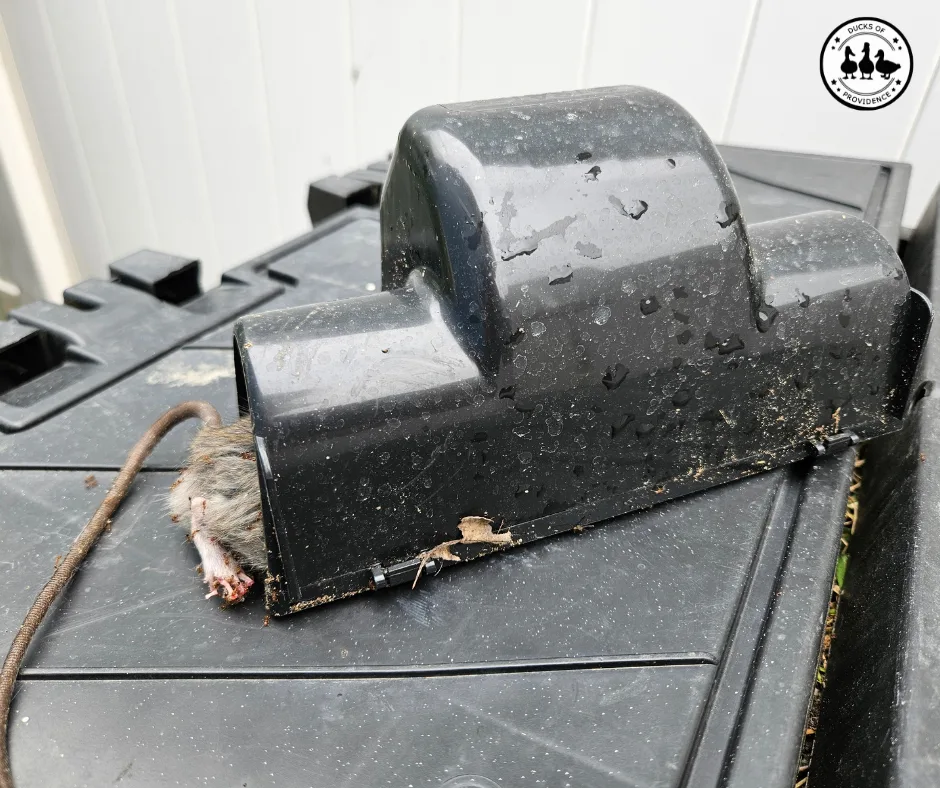
Rodent Control in the Duck Run: Safe and Effective Strategies for Duck Keepers
Rodents are opportunistic, persistent, and surprisingly good at sneaking into places they shouldn’t be—especially when food, warmth, and shelter are involved. For duck keepers, this can quickly become a serious problem. Rats and mice don’t just steal food; they contaminate it, chew through structures, and can even pose a direct threat to ducklings. The good news? With proper prevention and duck-safe strategies, you can protect your flock and keep your run rodent-free.
In this post, we’ll guide you through why rodent control is crucial for your ducks’ health and safety, how to prevent infestations in the first place, and what control methods are safe to use around ducks.
Ducks of Providence is free, thanks to reader support! Ads and affiliate links help us cover costs—if you shop through our links, we may earn a small commission at no extra cost to you. Thanks for helping keep our content free and our ducks happy! 🦆 Learn more
Why Rodent Control Matters
1. Rodents Spread Dangerous Diseases
Rats and mice are vectors for a variety of zoonotic diseases—those that can be transmitted from animals to humans or other animals, including ducks. Their urine, feces, saliva, and nesting materials can all harbor harmful pathogens.
Some key examples include:
- Leptospirosis: Transmitted through urine-contaminated water or surfaces. Ducks exposed to Leptospira bacteria may experience lethargy, reduced egg production, or, in rare cases, organ damage. This disease can also be passed to humans through open cuts or mucous membranes.
- Salmonella: Rodents can carry and shed Salmonella bacteria, contaminating feed and water. While many ducks carry salmonella asymptomatically, young or stressed birds can get sick—and this pathogen is also a concern for humans, especially in backyard flocks.
- Tyzzer’s Disease: Caused by Clostridium piliforme, this disease can affect a range of species and is often fatal in young or immunocompromised animals. It spreads through rodent feces.
- Lymphocytic choriomeningitis virus (LCMV) and Hantavirus: These are primarily human health threats but underscore the need for proper rodent sanitation in and around animal housing.
Even if your ducks don’t appear sick, chronic exposure to pathogens in their environment can wear down their immune systems, making them more vulnerable to other illnesses, parasites, or reproductive issues.
2. Contaminated Feed Is a Hidden Risk
Rodents are messy eaters. Even if they only nibble at your ducks’ feed, the contamination they leave behind poses a serious health risk. Their:
- Droppings contain bacteria and parasites
- Urine soaks into grain, making it unsafe
- Hair and nesting material can introduce mites, lice, or fleas
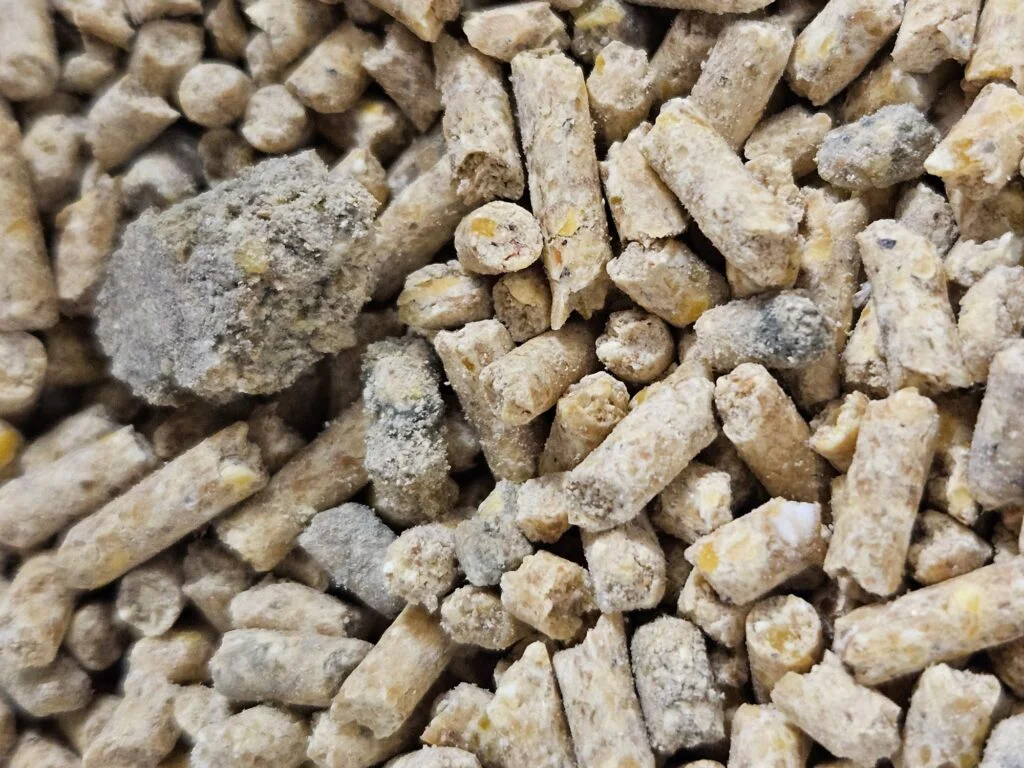
Worse, contaminated feed may not look or smell any different at first glance. If not stored and served properly, it can be difficult to know whether what your ducks are eating is safe.
Additionally, once rodents find a consistent food source, they’ll keep coming back—often bringing friends.
3. Rodents Cause Structural Damage
Rats and mice have powerful, ever-growing incisors that they must constantly wear down. That means they chew—everything.
In your duck run or coop, they can:
- Chew through plastic feed bins, egg boxes, or nesting areas
- Gnaw on wooden coop frames, weakening structural integrity
- Damage insulation or wiring in heated duck houses or winter setups
- Open tiny access points for themselves and larger predators by widening small cracks or holes
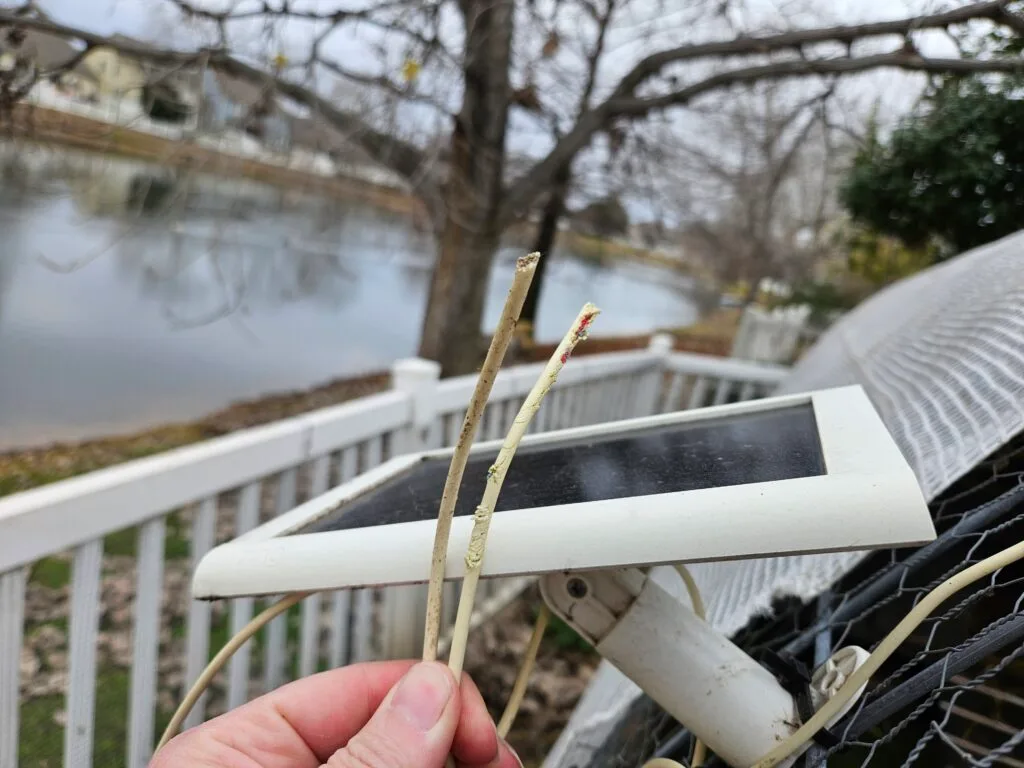
This kind of damage isn’t just costly—it can create serious safety issues for your ducks, especially if it compromises the predator-proofing of their enclosure.
4. They Threaten Ducklings and Weaken the Flock
It’s horrifying, but it needs to be said: large rat populations have been known to kill ducklings and other small poultry, especially at night. If ducklings are unprotected or the run isn’t fully enclosed, rats may:
- Bite or maim them
- Drag them away through holes or tunnels
- Steal newly laid eggs or even partially developed eggs in brooders
Even adult ducks are vulnerable if they’re injured or unable to defend themselves. Constant rodent presence can also lead to chronic stress in your flock, which impacts:
- Egg laying (ducks may lay fewer or stop entirely)
- Immune health
- Feather condition and preening behavior
Stress hormones like corticosterone spike when animals feel threatened, and chronic stress can have long-term consequences on your flock’s health and behavior.
5. Rodents Attract Bigger, More Dangerous Predators
Rodents don’t exist in isolation—they’re part of a broader ecosystem, and where there are rats, predators follow. Common animals attracted by a rodent presence include:
- Snakes (especially rat snakes): Can sneak into duck houses through the same openings as rats and consume eggs or small ducks
- Raccoons and opossums: Drawn to spilled feed and rodents—both of which increase the likelihood of a predator attack
- Owls and hawks: May start coming closer to your run once rodents are active at dusk or dawn
- Foxes and coyotes: Attracted by both the rodents and the scent of your ducks
By keeping rodents under control, you also reduce the interest of these higher-level predators and protect your flock from the cascading dangers of the food chain.
From Our Duck Run: When Rodents Chewed Through Everything
We didn’t always think rodents were a serious problem—until they proved it to us. A few months ago, we noticed odd tearing in our artificial turf, which we had laid down to give our ducks a cleaner, softer surface. At first, we assumed it was general wear and tear.
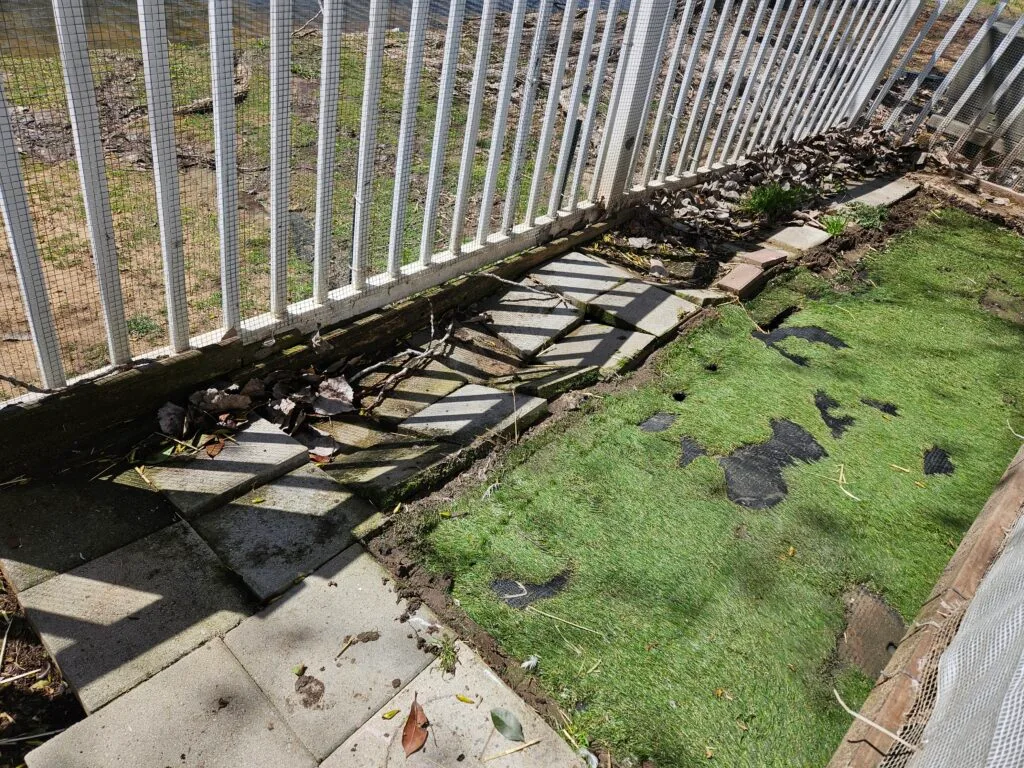
Then our solar-powered security camera stopped working.
When we checked, we discovered the cable to the solar panel had been completely chewed through—by rats. Not only had they tunneled under the run and gnawed through the turf from below, but they also went for the soft insulation and wiring, rendering the camera useless. It was an expensive and frustrating wake-up call.
Rodents may seem harmless at first glance, but they’re more destructive than many people realize—and they’ll exploit even the smallest opportunity if your run isn’t secure.
Prevention First: Smart Strategies That Work
The best rodent control starts with making your duck area unappealing to them. Here’s how:
1. Remove Food and Water at Night
Ducks are not nocturnal—they sleep through the night and don’t need access to feed after sundown. But rodents? That’s when they’re most active. Leaving food or water out overnight is like putting out a welcome mat for rats and mice.
Here’s how to shut down the buffet:
Secure or Remove All Food Sources
- If you’re using open bowls or trays, bring them inside after your ducks are safely put up for the night. Remove any food that is scattered around their food bowl.
- If you’re using a feeder, opt for one with a secure lid or automatic closure—we personally use an automatic feeder that closes at sunset, and it’s made a huge difference.
- For any backup or bagged feed, store it in a metal bin with a tight-fitting lid. Plastic bins may seem convenient, but determined rodents can and will chew right through them.
- Don’t scatter feed in the late afternoon or evening. What your ducks don’t eat will be left on the ground, attracting rodents, raccoons, and ants.

Water Can Attract Rodents Too
Rodents don’t just come for food—they come for water, especially during dry weather.
- Dump out water bowls at night, or use containers you can easily rinse and refill in the morning.
- Make sure no leaky hoses or dripping buckets are near your coop or run—standing water is an invitation to both rodents and mosquitoes.
- If you use a gravity-fed watering system or poultry nipple setup, just check regularly to ensure it doesn’t drip.
By removing access to food and water overnight, you’re not just protecting your ducks—you’re disrupting the routine of the rodents. And once they realize there’s nothing to gain from visiting, they’ll move on. It’s a small change with a big payoff.
2. Reinforce the Run Structure
No matter how clean your setup is, if rodents can physically get inside your duck run, they will. Rats can squeeze through holes the size of a quarter, climb vertical walls, and dig tunnels several feet long. If your run has even a small gap or a weak point, they’ll find it.
A rodent-resistant duck run starts with secure materials and thoughtful design. Here’s how to make sure they stay out—for good.
Use ¼-Inch Hardware Cloth—Not Chicken Wire
Chicken wire is meant to keep chickens in, not predators or pests out. Rats can easily squeeze through or chew through it. Instead:
- Use ¼-inch galvanized or polymer coated hardware cloth for all sides of your run, including walls, doors, and especially vents or open windows.
- Make sure it’s secured tightly with screws and washers—staples alone can loosen over time.
- Inspect the entire perimeter regularly for signs of tampering or sagging mesh.
Keep in mind that ½-inch hardware cloth is sturdier than ¼-inch and typically offers better protection against larger predators. While ¼-inch mesh is often recommended for rodent prevention, the ½-inch size may still be effective in many cases—especially if it’s securely installed. Some duck keepers choose to use both sizes together, placing the stronger ½-inch mesh on the outside for structural strength and adding ¼-inch mesh on the inside for extra rodent resistance.
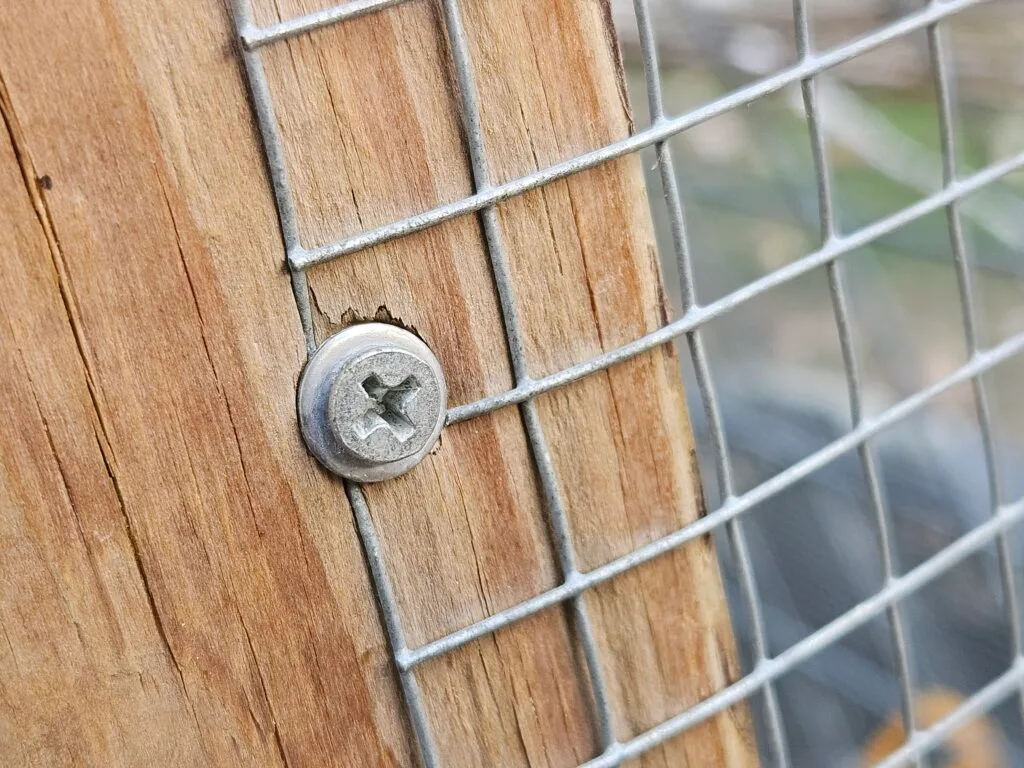
Bury the Edges to Stop Burrowing
Rodents are persistent diggers. If they can’t climb in, they’ll try to go underneath.
To stop them:
- Dig a trench around the entire base of your run and bury the hardware cloth at least 12 inches deep.
- For added protection, bend the mesh outward in an L-shape, so it extends horizontally for another 12 inches underground. This design discourages digging right up against the wall.
- If burying mesh isn’t feasible, lay a wide strip of hardware cloth or paver stones flush along the outside perimeter to create a no-dig barrier.
Seal Gaps and Check Hidden Entry Points
Rodents are excellent at finding the small cracks we overlook:
- Elevated duck houses: Check underneath regularly. These can become hidden nesting areas for rodents if the space is not enclosed or if bedding spills over the edges.
- Where walls meet the ground or framing—seal these tightly with metal flashing or overlapping mesh.
- Around door hinges, latch holes, or ventilation gaps—add extra mesh or weatherproof sealant if needed.
Making these upgrades takes some effort, but once they’re in place, your run becomes significantly more secure—not just from rodents, but also from snakes, weasels, and other burrowing predators.
3. Keep the Area Clean
Even the most secure duck run can attract rodents if it offers cozy nesting spots and easy access to food scraps. Rodents don’t need much—a small pile of straw, a quiet corner under a bush, or even spilled feed on the ground can be enough to encourage them to settle in.
Staying on top of daily and weekly cleanup tasks goes a long way in making your duck area inhospitable to unwanted visitors.
Sweep Up Leftover Feed Daily
Ducks are messy eaters. They’ll sling pellets around, step in them, and leave behind enough scraps to draw in nighttime foragers.
- After your ducks are done eating, do a quick sweep or rake of the feeding area.
- If you feed in bowls or shallow trays, tip them out and rinse them in the evening before putting them away.
- For scatter feeding, especially with grains or peas, keep it limited to morning hours and only offer what they’ll finish.
Consistent cleanup breaks the cycle of rodents returning to the same feeding spots.
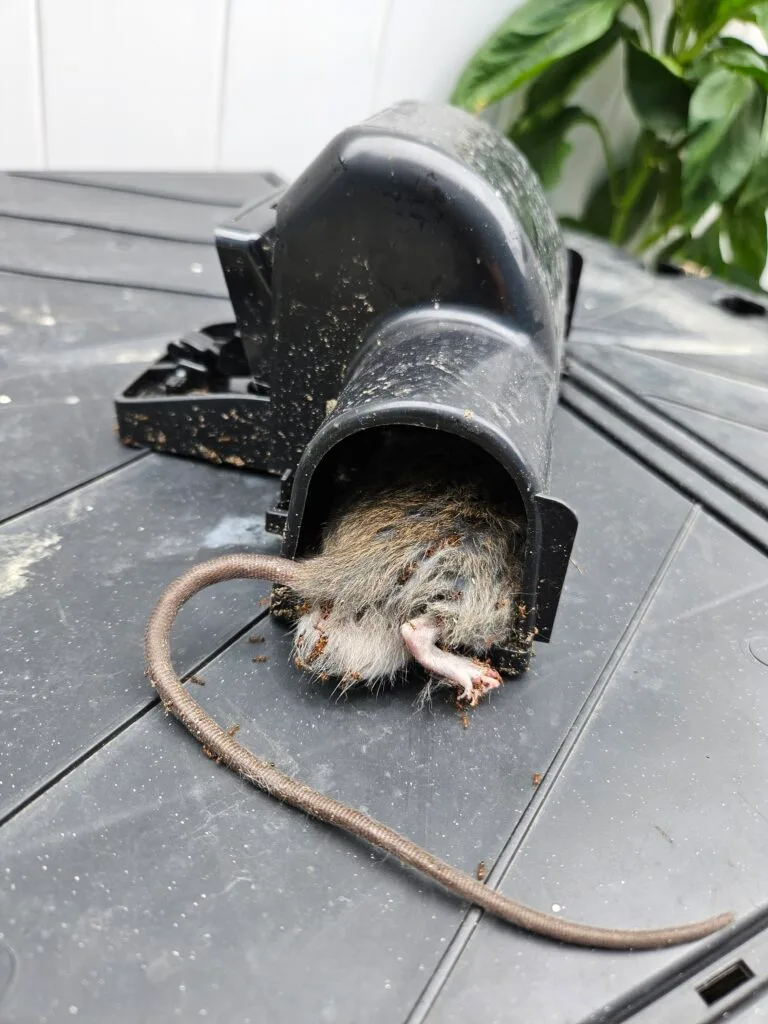
Remove Hiding and Nesting Materials
Rodents love to nest in undisturbed piles of:
- Straw or hay
- Firewood or lumber
- Leaf litter
- Garden supplies like tarps or empty pots
Do a quick inspection of the area around your duck run. If you store extra bedding, make sure it’s in a sealed, elevated container—ideally one made of metal or heavy-duty plastic with locking lids.
Avoid letting old materials pile up. If it sits for more than a couple days unused, it’s likely to become a cozy hiding spot.
Trim Vegetation Around the Perimeter
Overgrown grass, ivy, and low shrubs along your duck run give rodents cover and a chance to sneak in unseen.
- Keep grass and weeds trimmed around the outer edge of your run and coop.
- Trim branches or vines that hang too close—they can be climbing aids for rats and squirrels.
- Avoid stacking hay bales or compost piles directly next to the run walls.
Maintaining open space around your duck area not only deters rodents but also helps you spot tunnels or droppings before a full infestation starts.
Elevate Your Duck House
If your duck house is set directly on the ground, you’re giving rodents access to one of their favorite types of shelter: a dark, warm, protected spot under the floorboards.
- Elevate the house 6 to 8 inches off the ground on concrete blocks, treated wood legs, or a platform.
- Leave the space open so you can see underneath and inspect it regularly.
- Avoid skirting the area with boards or lattice, which can provide visual cover but still let rodents sneak underneath.
We keep our house elevated just high enough that we can fit a rake or broom under it for easy cleaning and inspection.
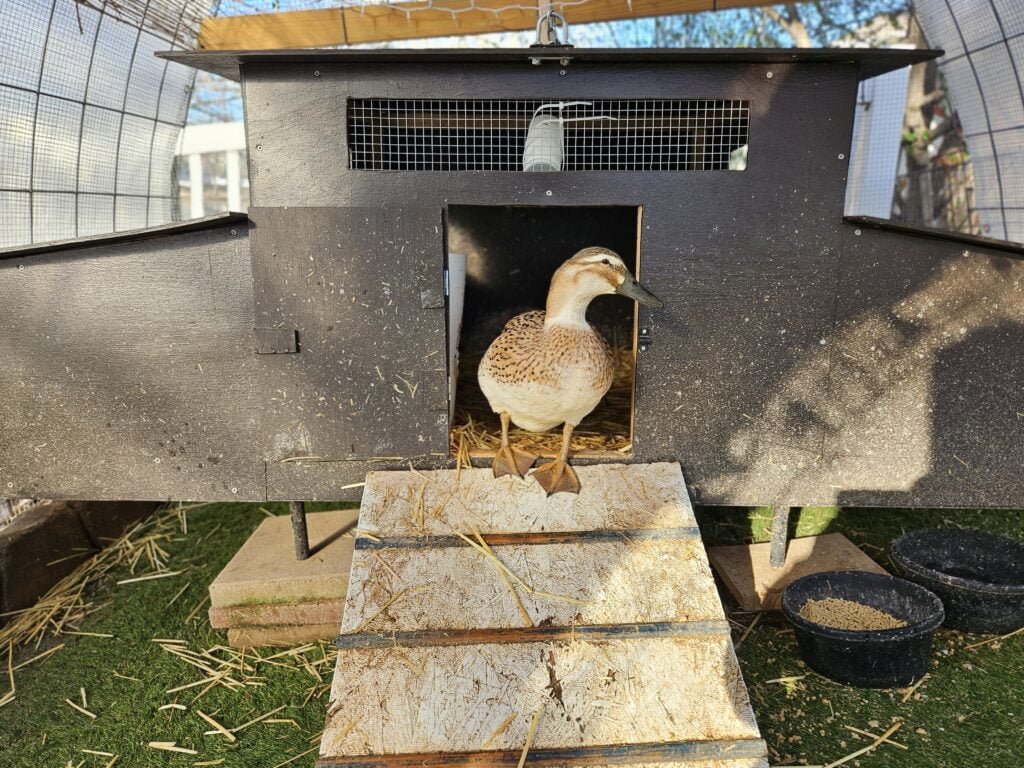
Small changes to your maintenance routine can make a big difference. Rodents are drawn to areas where they can hide, nest, and eat without disturbance. A clean, open, well-kept run tells them they’re not welcome here.
4. Duck-Safe Feed Storage
Even if you clean up feed daily and use an automatic feeder, you’re still at risk of attracting rodents if your feed storage isn’t secure. Mice and rats can smell duck feed from a surprising distance—and if they find a way in, they’ll keep coming back night after night.
Safe, rodent-resistant storage is a foundational part of any prevention plan.
Metal Is Best—But Plastic Can Work (With Caution)
Rodents can easily chew through regular plastic bins, especially if they’re stored outdoors or in sheds where pests are already present. Whenever possible, we recommend:
- Galvanized metal containers with tight-fitting or locking lids
- Raised platforms to keep containers off damp ground and prevent burrowing underneath
That said, if you use plastic, choose only high-quality, hard plastic bins with a close-fitting lid. Thin or soft plastic won’t stand up to chewing.
In our case, we store feed in the garage—well away from the duck run and out of reach for rodents. This minimizes risk even if the container material isn’t chew-proof.
Keep Feed Dry and Elevated
Moisture and feed don’t mix. In addition to mold and spoilage, damp storage areas are more inviting to rodents and insects.
- Store feed in a covered, enclosed area that stays dry year-round.
- Elevate containers using bricks, pallets, or shelving to improve airflow and reduce hiding spots.
- Keep containers away from bedding, trash, or compost bins that might harbor pests.
Even indoors, regularly check lids and corners for signs of chewing or droppings—especially if feed is stored near doors or garage walls.
Cleanliness Counts
Rodents often discover feed storage areas because of scattered pellets, spilled dust, or open scoops.
To avoid drawing them in:
- Wipe down containers after each refill
- Use a dedicated scoop or measuring cup with a lid
- Sweep the surrounding area frequently, especially in garages or storage sheds
We’ve made it part of our routine—every time we refill the feeder, we do a quick check for signs of tampering or spills.
Buy What You Can Store Safely
Buying in bulk is convenient and cost-effective, but only if you have a rodent-proof place to store it.
If you’re battling an active rodent issue, it’s often better to:
- Buy feed in smaller quantities
- Rotate through bags more frequently to prevent spoilage
- Store any extra feed in your home or garage—like we do—rather than outside or in the run
Safe feed storage does more than protect your feed investment—it protects your flock’s health and helps break the cycle of rodent attraction in and around your duck space.
From Our Duck Run: How We Reinforced Against Rodents
After dealing with rodent damage firsthand, we made several upgrades to our setup to keep our ducks safe—and to avoid repeating the experience.
First, we added an automatic feeder programmed to close at sunset. This ensures that no feed is available overnight when rodents are most active. It’s been one of the most effective changes we’ve made. Since ducks don’t eat after dark, there’s no downside for them—and it dramatically reduced nighttime visits from rats.
We also had to replace our artificial turf and the solar panel cable for our security camera, both of which were damaged by chewing. When we reinstalled the turf, we filled the soil underneath to fill the tunnels and laid down an additional barrier beneath the turf to make tunneling more difficult.
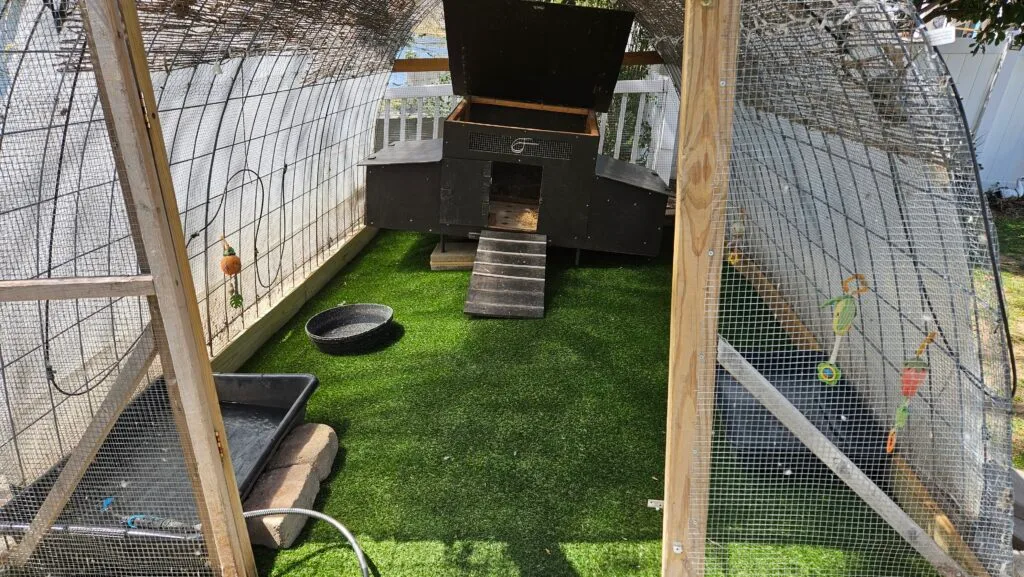
To control the existing rodent population, we started using modern snap traps—the kind designed to be safer around pets. These traps are enclosed and very effective, and we placed them outside the duck run in fenced-off areas where ducks or other animals couldn’t accidentally access them.
At first, we baited the traps with peanut butter, which worked well—but we quickly discovered it attracted ants. So we switched to a handful of our ducks’ regular feed as bait, which proved just as effective without the added problem of insects.
Since implementing these changes, we haven’t seen any new signs of rodent activity—and our ducks have been safer and more comfortable because of it.
Safe Rodent Control Methods Around Ducks
Even with the best prevention efforts, you may still find yourself needing to actively control rodents—especially if they’ve already found their way into your space. But when you keep ducks, not all control methods are safe, and some commonly used options (like poisons) can actually put your birds in danger.
The goal is to eliminate the rodents without risking your ducks’ health—or the safety of other pets and wildlife.
1. Use Pet-Safe Snap Traps – Carefully and Strategically
We’ve had the best success using modern snap traps designed to be safer around pets. These traps are:
- Fully enclosed or shielded to reduce risk of accidental contact
- Easy to set and reset
- Very effective when placed correctly
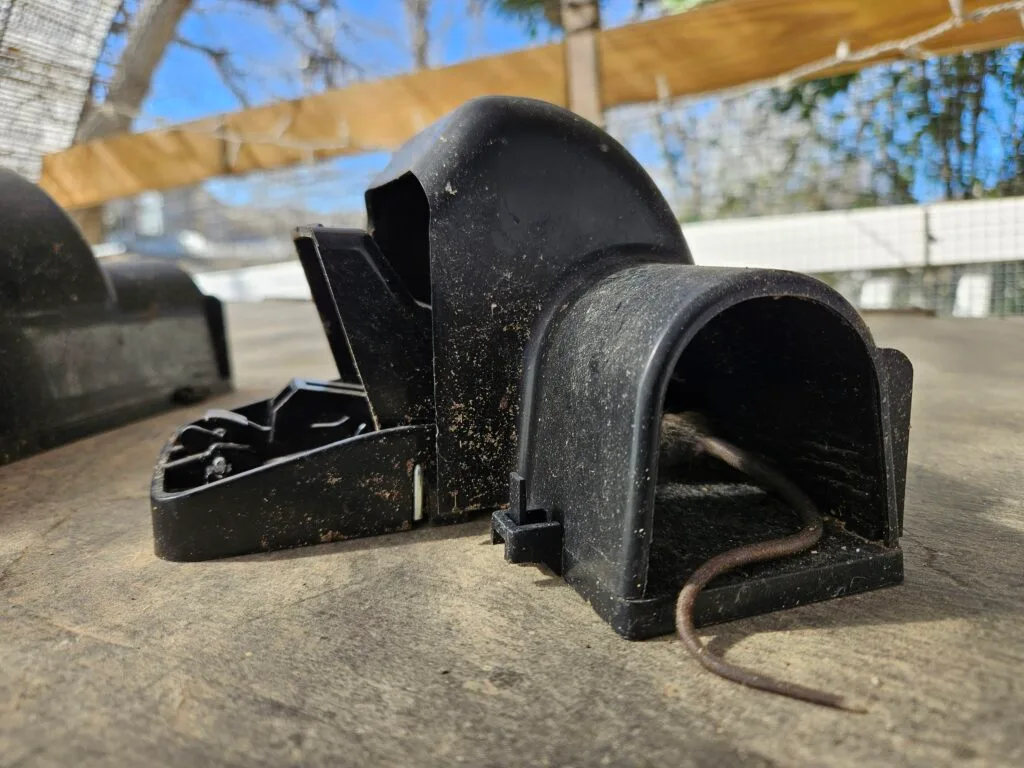
We only place them outside the duck run, in fenced-off areas where our ducks—and other animals—can’t access them. Keeping them physically separated from your flock is essential, no matter how “safe” the design claims to be.
Where to Place Traps
- Along walls or fence lines where you’ve seen droppings or gnaw marks
- Near burrow entrances or known rodent paths
- Inside small shelters or boxes with one entry/exit (we use simple plastic crates with holes drilled for rodent entry)
Change locations every few days if you’re not seeing results, or switch baits if ants or other pests show up.
Bait Tips From Experience
- Peanut butter works well, especially for mice and smaller rats—but in our case, it started attracting ants, which caused a new problem.
- We switched to using a small handful of duck feed—especially pellets—and have found it equally effective without attracting insects.
Use just enough bait to get their attention—too much may cause mess or allow rodents to steal it without triggering the trap.
2. Avoid Poisons at All Costs
Rodenticides are one of the biggest hazards in backyard setups with birds or pets. The risks include:
- Secondary poisoning: If your duck (or a wild bird) eats a poisoned rodent
- Direct poisoning: If bait falls or blows into your duck area
- Environmental harm: Many modern rodenticides persist in the ecosystem and harm non-target wildlife
Because of these risks, we never use poison—and we strongly recommend that duck keepers avoid it entirely.
3. Don’t Use Glue Traps
Glue traps are not only inhumane—they’re dangerous. Birds, reptiles, and even ducklings can get stuck in them. Removal is painful and often fatal for unintended victims.
These traps are best avoided altogether, especially in mixed-species or outdoor environments.
4. Create Physical Barriers for Trap Safety
If you want to set traps closer to the run or coop:
- Use a fenced-off corner or box your ducks can’t reach
- Cover snap traps with a milk crate or hardware cloth tunnel, only allowing rodents inside
- Label or flag trap zones clearly so you remember where they’re placed
Rodents are most active at night, so check traps first thing in the morning and reset or dispose of any that were triggered.
5. Monitor, Rotate, and Reassess
Rodents are smart. If they see other rodents caught or sense something is off, they may begin avoiding traps. To stay ahead of them:
- Change bait types occasionally
- Rotate trap locations every few days
- Combine trapping with other control strategies (like sealing burrows or reinforcing fencing)
We’ve found that traps combined with proper food storage and run reinforcement has kept our rodent pressure low—even after a significant problem earlier on.
💡 Tip: Always wear gloves when handling traps to avoid transferring human scent.
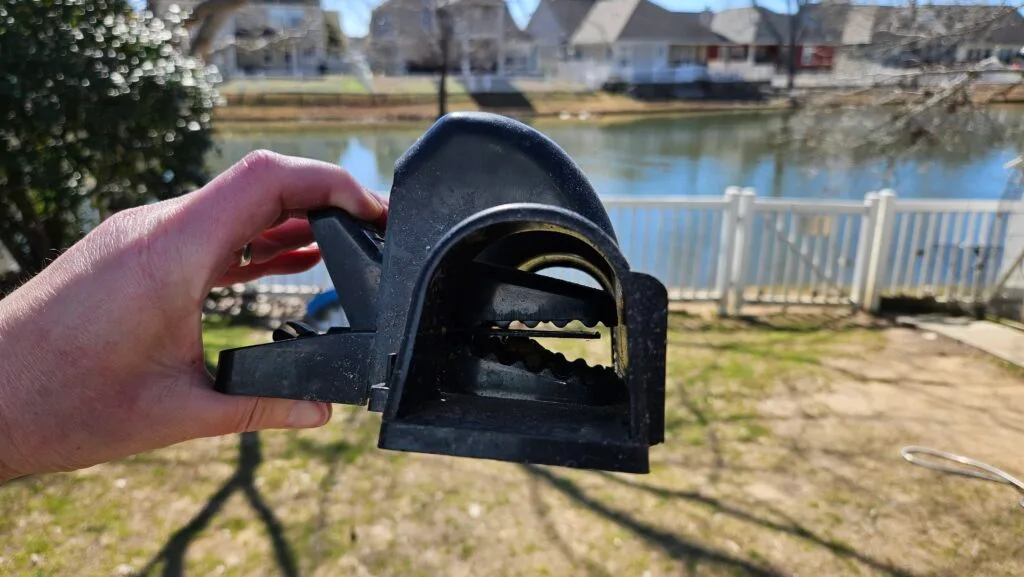
6. Natural and Low-Impact Deterrents
If you’re not ready to use traps—or you want to support your prevention strategy with extra layers of defense—natural deterrents can help. While these methods aren’t usually effective as standalone solutions, they can reinforce your other rodent control efforts in a way that’s non-toxic and duck-safe when used carefully.
Peppermint Oil
Peppermint oil is one of the most commonly recommended natural rodent deterrents. The strong menthol scent can irritate rodents’ sensitive noses and discourage nesting—in theory. Here’s what to know:
- Soak cotton balls in pure peppermint essential oil and place them in enclosed or sheltered areas where rodents might sneak in—like under feed storage shelves, behind bins, or near coop corners.
- Replace or reapply every few days to maintain potency.
- Effectiveness is limited to indoor or enclosed spaces. Outdoors, the scent dissipates quickly, especially in wind or rain.
While peppermint oil is unlikely to solve an infestation, it may help discourage scouting rodents from choosing your coop or garage as a nesting spot—especially when combined with physical barriers.
Predator Urine Granules
Some duck keepers use predator urine, like fox, bobcat, wolf, or coyote urine, as a way to simulate a threat in the environment. It typically comes as granules or a spray.
- These granules are usually applied along the outer perimeter of your run, garden, or storage area to make rodents think predators are nearby.
- Use caution: Never apply them near the duck house or coop, as the strong scent can confuse or stress your ducks. They may associate the smell with real predators.
- Reapply after rain or heavy dew, as moisture dilutes the scent.
In our experience, this is a better choice for deterring rodents from approaching feed sheds or garage storage areas, rather than something we’d use directly around the flock.
Motion-Activated Lights or Sprinklers
Rodents and other night-time visitors (like raccoons or opossums) prefer to work under cover of darkness and silence. Sudden movement, lights, or bursts of water can be enough to startle them away.
- Install motion-activated solar lights along the perimeter of your run or near entrances to sheds.
- Motion-activated sprinklers can also be effective, especially for discouraging larger animals.
- These devices are generally safe around ducks as long as they’re not aimed directly into the coop or where ducks sleep or eat.
We’ve found them helpful for keeping larger nocturnal pests away, but not a reliable solution for small rodents unless paired with other methods.
7. Farm Cats – Proceed with Caution
Cats and poultry can coexist—but it depends heavily on the individual cat, your ducks’ personalities, and how carefully you introduce them. Farm cats, especially, can help keep rodent populations in check around your property if managed responsibly.
Choose the Right Cat for the Job
Not every cat is a good match for life around ducks. Here’s what we recommend:
- Choose a cat with poultry experience or one raised around birds and small animals.
- Adopt from rescues that socialize barn cats or offer adoption programs specifically for farms.
- Avoid placing feral or unsocialized cats directly into duck environments without a proper rehabilitation period. These cats may view ducklings as prey.
Supervise Early Interactions
- Always introduce slowly and under supervision, especially if your ducks are small or nervous.
- Watch how the cat reacts to ducks flapping or moving quickly. A startled or playful reaction is common—but predatory behavior should be corrected or redirected immediately.
- Make sure ducks have safe retreat areas in case they feel threatened.
Over time, a cat that learns the ducks are off-limits can become a valuable rodent deterrent—just their scent and presence can keep rodents at bay.
Provide Shelter and a Defined Territory
If you’re keeping a barn cat specifically for rodent control:
- Provide a safe sleeping area, food, and fresh water away from the duck area, so the cat doesn’t start stealing duck feed.
- Monitor for signs of interaction with wildlife or other pets.
- Spay or neuter to avoid territorial behaviors that could complicate life around your flock.
When to Call a Professional
Signs you may need expert help:
- Gnaw marks or holes in feed storage
- Burrow tunnels around your run
- Droppings near or inside your duck house
- Rodents seen during the day (a sign of heavy infestation)
Ask for a licensed pest control technician who:
- Specializes in animal-safe farms
- Uses non-toxic, integrated pest management methods
Frequently Asked Questions (FAQ)
Can ducks help control rodents?
Not really. While ducks are curious and may occasionally chase or peck at small mice, they are not natural rodent predators. In fact, rodents are more likely to take advantage of a duck’s feeding habits—messy eating, spilled food, and overnight water access—than be scared off by them.
Male ducks (drakes) might bluff-charge a rat if they see one, but this isn’t a reliable defense. Some ducks might even be startled or stressed by rodent activity, especially at night.
What kind of traps are safe to use around ducks?
The safest traps are modern enclosed snap traps, which are designed to be lethal to rodents while reducing the risk to pets and non-target animals. We use these outside the run, fenced off or in secure containers that ducks cannot access.
Avoid:
- Glue traps – inhumane and dangerous for ducks and wildlife
- Rodenticides – highly toxic, even in small amounts, and can cause secondary poisoning if a duck eats a poisoned rodent
Always check traps daily and never place them where ducks, chickens, dogs, or cats can reach them.
How do I know if I have rodents in my duck run?
Early signs include:
- Small droppings (often rice-shaped and dark) near feed bins, corners, or water sources
- Gnaw marks on plastic bins, wood, or wiring
- Feed disappearing faster than usual, especially overnight
- Burrows or small tunnels near the base of the run or coop
- Ducks acting nervous or refusing to enter certain areas
Seeing a rat during the day usually means the infestation is already significant—they typically only show themselves in daylight when populations are high or food is scarce.
Can rats or mice hurt ducks?
Yes, especially ducklings or injured ducks. In severe infestations, rats have been known to:
- Bite ducklings or steal eggs
- Attack molting or weak ducks
- Cause infection through bites or scratches
While adult, healthy ducks are rarely targeted, the stress and hygiene issues rodents bring can still impact their health and egg production.
Are electronic rodent repellents safe to use near ducks?
Ultrasonic repellents claim to drive rodents away using high-frequency sounds, but their effectiveness is debated. Some points to consider:
- They should never be placed inside the duck coop, as the frequency might be uncomfortable or stressful for your birds.
- Placing them in storage sheds or garages can help deter mice in those specific areas without affecting the flock.
Always observe your ducks for changes in behavior if you install one nearby.
Is it possible to completely eliminate rodents, or just control them?
In most backyard settings, the goal should be consistent control, not total eradication. Even with perfect prevention and traps, new rodents may enter from surrounding areas, especially in rural or wooded neighborhoods.
Think of rodent control like predator-proofing: it’s about layered protection, consistency, and staying one step ahead.
How often should I check for rodent signs?
We recommend doing a quick visual inspection weekly—look for droppings, disturbed soil, gnaw marks, or chewed materials. During cooler months or after rain (when rodents seek shelter), check more frequently.
Also:
- Refresh peppermint oil deterrents or reapply predator urine as needed
- Inspect underneath duck houses if they’re raised
- Check around feed bins and storage areas
Final Thoughts
Rodent control is one of the many responsibilities that come with keeping a healthy duck flock. While it might feel overwhelming, the best results come from a combination of preventative strategies and duck-safe controls. By removing food at night, securing your run, and using humane, poison-free solutions, you protect your ducks and your peace of mind.
Keeping a clean and secure environment doesn’t just keep rodents out—it ensures your flock thrives.






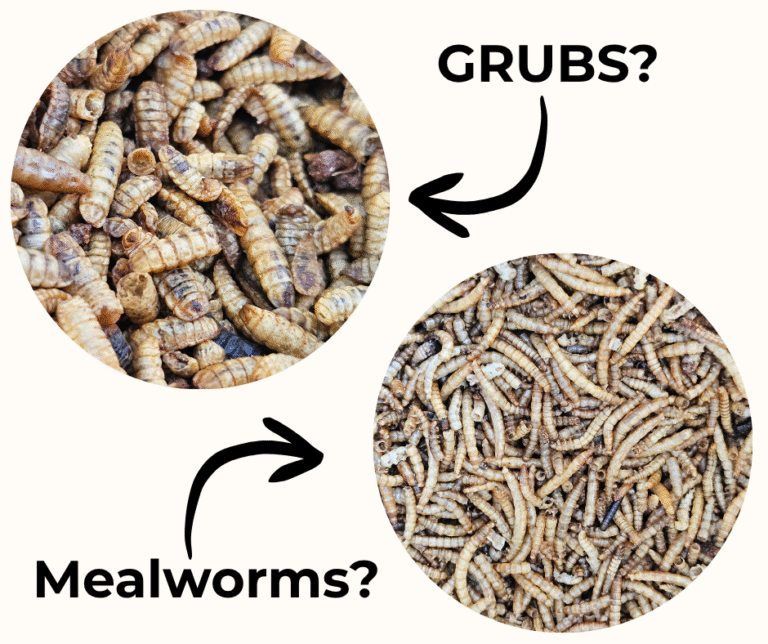
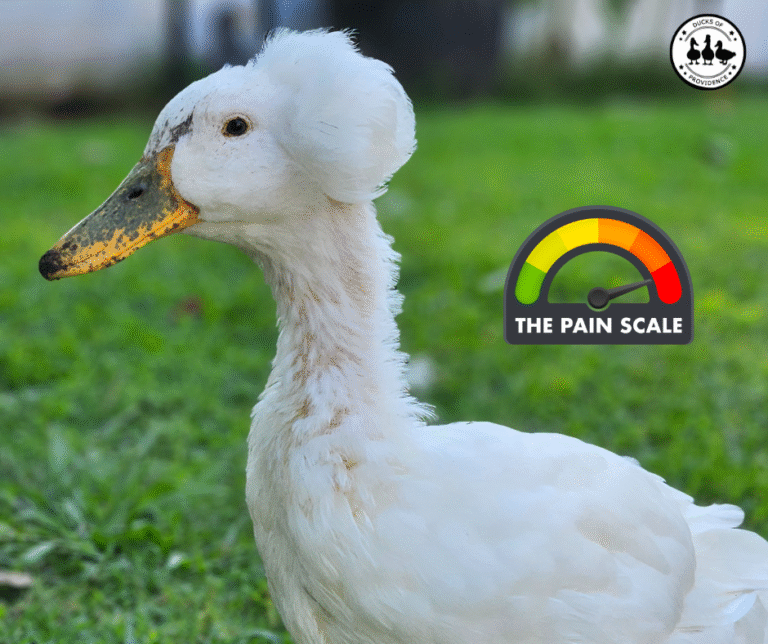
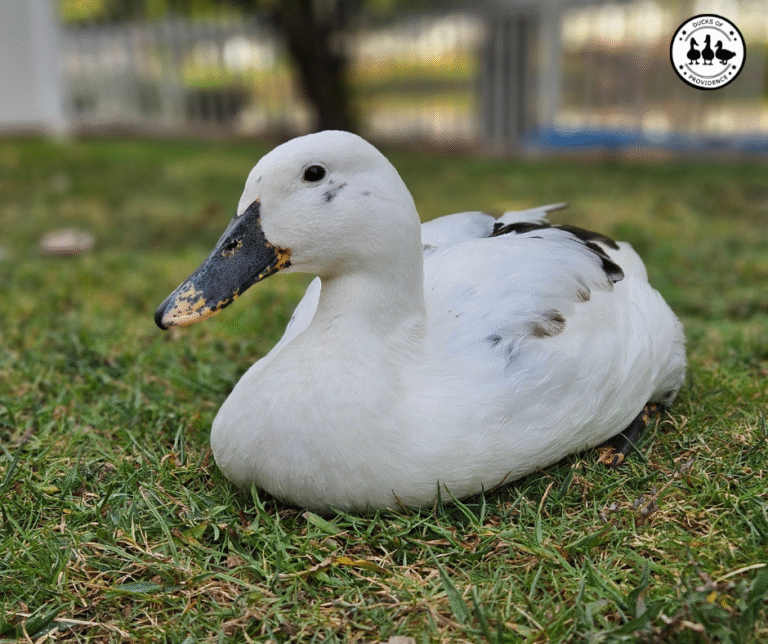
In garden or yard it is very difficult to manually do anything about these rodents. The best thing would be to have plants which deters them or have fencing. Because of the damp soil it would be difficult to prevent burrow being made. Other best option is to go for pest control services.